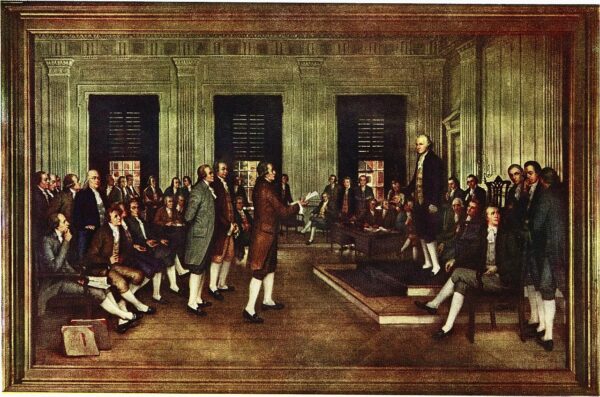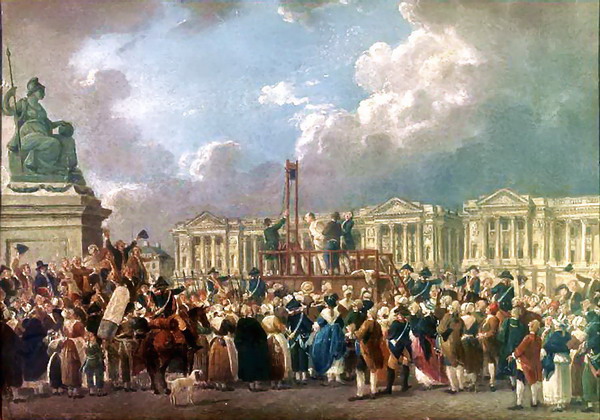The 1787 Constitution-along with the subsequent Bill of Rights, the famous American constitutional amendments-is the supreme law of the United States. It was drafted in its original form by members of the Constitutional Convention in Philadelphia, Pennsylvania, and signed on September 17, 1787, nearly two years before the French Revolution, making it the world’s oldest constitutional text still in force. The Philadelphia Convention is one of the central episodes in U.S. history, with the participation of such prominent figures as James Madison, the nation’s fourth president, Alexander Hamilton, the first secretary of the Treasury, the great inventor, politician, and scientist Benjamin Franklin, and the first president of the newborn country, George Washington, who was elected by the 55 delegates present to preside over the meetings as well.

Contents
What happened at the constitutional convention?
The initial aim of the Convention was only to reform the so-called Articles of Confederation, the first U.S. government document, in force since 1781 and which was clearly proving insufficient to respond to all the problems arising after Independence. Thus, by September 1786, commissioners from five states had met at the Annapolis Convention to discuss such reforms, and shortly thereafter invited representatives of the remaining states to join the federal government’s plan for improvement. Thus the Philadelphia Convention was convened on May 14, 1787, specifying that its purpose was to make such amendments, but it was soon decided instead to replace the Articles with a Constitution. The commissioners chose to keep their deliberations secret and established, once the constitutional text was approved, that nine of the thirteen states would have to ratify it in order for it to enter into force as a new national supreme law.
The Constitution, in its original form, contains only a preamble and seven articles devoted to the legislative, executive, and judicial branches of government – Montesquieu’s separation of powers was a direct influence on the text – the powers of the State and their limits, the amendment process, the power of each federal state, and the requirements for ratification of the Magna Carta. That endorsement was reached on June 2, 1788, when New Hampshire became the ninth required state, and the law went into effect shortly thereafter. However, some anti-federalist groups opposed it and some members of the Convention itself argued that the Constitution failed to explicitly uphold the basic principles of human liberty and proposed amending it. The result of this second constituent process was the aforementioned Bill of Rights, adopted on December 15, 1791, and made up of ten amendments. The most famous of these, which in the twentieth and twenty-first centuries would give rise to numerous Supreme Court rulings, are the First Amendment, which refers to freedom of speech, of the press, of religion, of peaceful assembly and of protest, the Second Amendment, which protects the right to keep and bear arms, and the Sixth Amendment, which establishes the trial by popular jury and other procedural rights.
The Philadelphia Convention, also known as the Constitutional Convention, the Federal Convention or the Great Convention in Philadelphia, took place from May 25 to September 17, 1787 to solve the problems of government of the United States of America, the government of which was defined according to the Articles of the Confederation after its independence of Great Britain. Although the convention allegedly met to review and reform Articles of the Confederation, the intention of many of the proponents, including James Madison and Alexander Hamilton, was from the beginning to create a new federal government, instead of “fixing “the existing one The delegates elected George Washington to chair the convention.
As a result, the only and current constitution of the United States, which created the United States federation with its present structure, was enacted, and therefore the convention is one of the most important historical events in the history of the United States.
Historical context
Before the Constitution was drafted, Federalists and Anti-Federalists agreed on the inefficiency of the government to manage the trade. Virginia and Maryland had reached an agreement on how to navigate the Bay of Chesapeake and respect their tax affairs and wanted Delaware and Pennsylvania to unite them. Such an agreement, however, was illegal without the consent of the Confederal Congress according to Article VI of the Articles of the Confederation. The frustration with regard to the agreement sparked at the Annapolis Convention, where only five states came forward to discuss possible remedies for trade. The convention set the date for the Philadelphia Convention in 1787.
Three events occurred that increased the legitimacy of the Philadelphia Convention. First New York vetoes Robert Morris’ 25-year plan to increase revenues after all other states had agreed (many with reservations). The nation was desperately in need of income to pay debts external to France and the Netherlands, to soldiers fighting against the Native Americans to the west, and to the general expenses of leading a government. The 1786 Tax applied for $ 3.8 million and received only $ 663 in terms. Second, the Rebellion of Shays shook the country. The rebellion to capture an arsenal in Massachusetts was suppressed with relative ease, but the news of the event scared people in all states and exposed the weaknesses of the Articles. Finally, blockages in the country due to debts demonstrated the weakness of the Articles and showed the inability of the government to solve the problem.
Deliberation
The convention was held in the Legislative Chamber of the State of Pennsylvania during the warm summer of 1787. The windows were kept closed and guards were placed so that other people could not hear the discussions. Rhode Island refused to send delegates to the convention.
The plan of Virginia
The Virginia Plan was the unofficial order of the day for the Convention. The delegation of Virginia arrived before the other delegations in Philadelphia and began to meet daily to discuss projects for the new government. All except the first resolution were written by James Madison and were reported in the Convention by Edmund Randolph.
The plan included:
- A bicameral legislature
- Members of both quarters proportionally determined
- The lower house would be chosen by the population of several states
- The High House would be chosen by the lower house appointed by the state legislatures
- The legislature would be very powerful
- An executive was planned, but it would exist to ensure that the will of the legislature was carried out, and elected by the legislature
- Formation of a judiciary, with a lifetime
- A Review Board consisting of the executive and some national judgments and would have the power to veto and revise national legislation
- The national legislature would be able to veto state laws
The plan of New Jersey
Some, like William Paterson, thought that if too much power was given to the government, or to larger states, they could destroy the smaller states and take control of the House, and smaller states would have little influence on future issues in the country. The New Jersey Plan was largely a response to the Virginia Plan. Patterson recounted the plan to the Convention on June 15, 1787.
This included:
- The current Congress remained but gained new powers. For example, Congress could impose taxes and force its collection
- An executive would be created, decided by the Congress (the Plan took into account a multipersonal executive)
- The executive would serve for a single term and would be subject to retirement at the request of state governors

